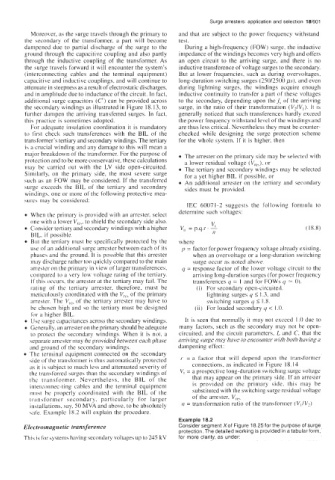Page 636 - Industrial Power Engineering and Applications Handbook
P. 636
Surge arresters: application and selection 18601
Moreover, as the surge travels through the primary to and that are subject to the power frequency withstand
the secondary of the transformer. a part will become test.
dampened due to partial discharge of the surge to the During a high-frequency (FOW) surge. the inductive
ground through the capacitive coupling and also partly impedance of the windings becomes very high and offers
through the inductive coupling of the transformer. As an open circuit to the arriving surge, and there is no
the surge travels forward it will encounter the system’s inductive transference of voltage surges to the secondary.
(interconnecting cables and the terminal equipment) But at lower frequencies, such as during overvoltages,
capacitive and inductive couplings, and will continue to long-duration switching surges (250/2500 ps), and even
attenuate in steepness as a result of electrostatic discharges, during lightning surges, the windings acquire enough
and in amplitude due to inductance of the circuit. In fact, inductive continuity to transfer a part of these voltages
additional surge capacitors (C’) can be provided across to the secondary, depending upon the J; of the arriving
the secondary windings as illustrated in Figure 18.13, to surge, in the ratio of their transformation (V2/VI). It is
further dampen the arriving transferred surges. In fact, generally noticed that such transferences hardly exceed
this practice is sometimes adopted. the power frequency withstand level of the windings and
For adequate insulation coordination it is mandatory are thus less critical. Nevertheless they must be counter-
to first check such transferences with the BIL of the checked while designing the surge protection scheme
transformer’s tertiary and secondary windings. The tertiary for the whole system. If it is higher, then
is a crucial winding and any damage to this will mean a
major breakdown of the transformer. For the purpose of The arrester on the primary side may be selected with
protection and to be more conservative, these calculations a lower residual voltage (VreJ. or
may be carried out with the LV side open-circuited. The tertiary and secondary windings may be selected
Similarly, on the primary side, the most severe surge for a yet higher BIL if possible. or
such as an FOW may be considered. If the transferred e An additional arrester on the tertiary and secondary
surge exceeds the BIL of the tertiary and secondary sides must be provided.
windings, one or more of the following protective mea-
sures may be considered:
IEC 6007 1-2 suggests the following formula to
determine such voltages:
When the primary is provided with an arrester, select
one with a lower V,,,, to shield the secondary side also. V,
Consider tertiary and secondary windings with a higher V,, = p.q.r - (I 8.8)
BIL. if possible.
But the tertiary must be specifically protected by the where
use of an additional surge arrester between each of its p = factor for power frequency voltage already existing,
phases and the ground. It is possible that this arrester when an overvoltage or a long-duration switching
may discharge rather too quickly compared to the main surge occur as noted above.
arrester on the primary in view of larger transferences, q = response factor of the lower voltage circuit to the
compared to a very low voltage rating of the tertiary. arriving long-duration surges (for power frequency
If this occurs, the arrester at the tertiary may fail. The transferences 9 = 1 and for FOWs 4 = 0).
rating of the tertiary arrester, therefore, must be (i) For secondary open-circuited.
meticulously coordinated with the V,,, of the primary lightning surges q 5 1.3, and
arrester. The V,,, of the tertiary arrester may have to switching surges q 5 1.8.
be chosen high and $0 the tertiary must be designed (ii) For loaded secondary q < I .O.
for a higher BIL.
Use surge capacitances across the secondary windings. It is seen that normally it may not exceed 1 .O due to
Generally, an arrester on the primary should be adequate many factors, such as the secondary may not be open-
to protect the secondary windings. When it is not, a circuited, and the circuit parameters. L and C. that the
separate arrester may be provided between each phase arriving surge may have to encounter with both having a
and ground of the secondary windings. dampening effect:
The terminal equipment connected on the secondary
side of the transformer is thus automatically protected r = a factor that will depend upon the transformer
as it is subject to much less and attenuated severity of connections, as indicated in Figure 18.14
the transferred surges than the secondary windings of V, = a prospective long-duration switching surge voltage
the transformer. Nevertheless, the BIL of the that may appear on the primary side. If an arrester
interconnec-ting cables and the terminal equipment is provided on the primary side. this may be
must be properly coordinated with the BIL of the substituted with the switching surge residual voltage
transformer secondary, particularly for larger of the arrester, V,,,
installations. say, 50 MVA and above, to be absolutely n = transformation ratio of the transformer ( VI/V2)
ufe. Example 18.2 will explain the procedure.
Example 18.2
Electromagnetic transference Consider segment Xof Figure 18.25 for the purpose of surge
protection. The detailed working is provided in a tabular form,
This is for systems having secondary voltages up to 245 kV for more clarity, as under:

